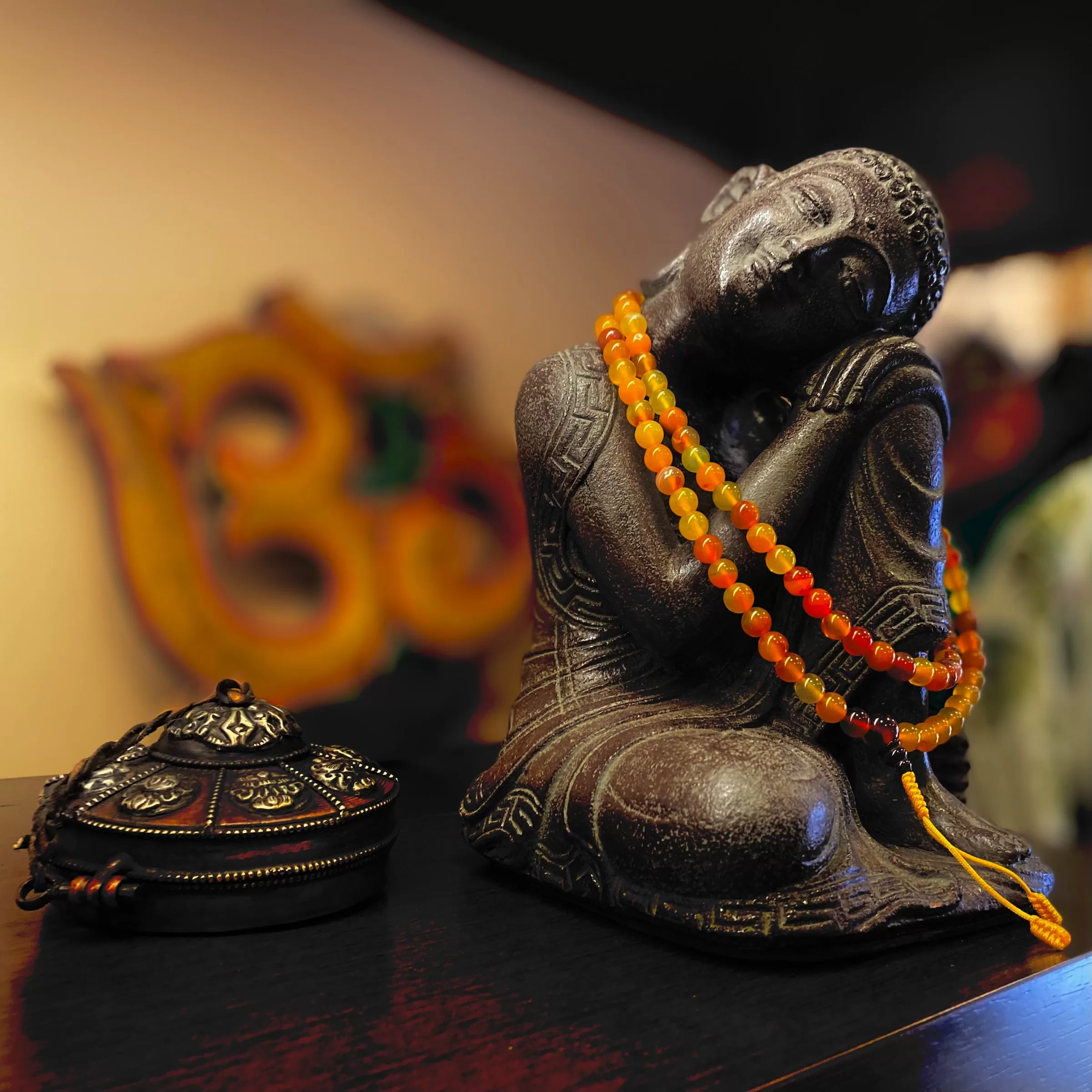The idea of using a mala in meditation is not a new concept, but one that has been gaining traction with experienced yogis in recent years. Many meditators have discovered the power of a mala to focus their awareness and deepen their mindfulness practice, both during and beyond the time spent in meditation.
In this guide, we will explore the various aspects of mala usage, from its spiritual properties to the correct physical posture and position for meditating with a mala. We’ll also discuss the ritual and meaning behind different types of mala, and what to look for in terms of quality, materials, and construction.
What is a Mala?
A mala is a string of beads — most commonly 108 beads, though there are variations — that is used to focus the attention and keep count during yoga or meditation. It’s conceptually similar to the use of rosary beads in Christian meditation and prayer, or the use of prayer beads in Buddhism. Malas can be made of various materials such as wood, semi-precious stones, crystals, or even seeds, each having its own unique energy signature.
Different Types of Mala
When selecting a mala, it’s important to consider the type of meditation you wish to practice. Different types of mala offer different benefits.
For example, Rudraksha beads are associated with Lord Shiva and are believed to offer protection and spiritual increase. The Sanskrit meaning of Rudraksha is “the eye of Shiva”.
Bodhi Seed mala are believed to evoke mindfulness and concentration, and are favored amongst Buddhist practitioners.
Mahamaya malas are associated with Mahamaya, who was the mother of Buddha. These malas are intended to offer insight and understanding through meditation.
Rainbow Sandstone malas offer protection by diffusing anger and hatred and absorbing negative energies, making them particularly popular in Tibet.
Physical Posture When Using a Mala
When practicing with a mala, it’s important to hold the mala in an ergonomic and natural position in your hand. If a mala is too large for your wrist, the best position is simply to hold the mala in your palm between your thumb and index finger.
The mala should lightly rest against the third finger. Once you have adjusted the position of the mala, gently close your fingers around the mala and stay still for a couple of seconds. Make sure your shoulders and neck are also in a relaxed position. It’s important to be comfortable and stable when using the mala, so that it doesn’t shift constantly while meditating.
Developing a Mantra Meditation Practice
A traditional mala beads meditation practice typically involves chanting a mantra and counting each recitation with a single bead. This type of meditation practice can range from 8 to 21 minutes, although many experienced meditators strive to practice mantra meditation for at least twenty minutes.
As you move along each bead of the mala with your fingers, chant the mantra and concentrate on the sound. If your mind begins to wander, gently bring it back to the sound of the mantra and the movement of the bead.
Significance of the Number 108
The number 108 is a symbolic figure in many spiritual practices, but its origin is still unclear. In Hindu mythology, the god Shiva is said to have 108 names. In Zen Buddhism, the number 108 symbolizes the earthly desires of man (6 senses multiplied by 3). In yogic practices, the number is associated with being grounded, as it is said to represent the individual capacity to move closer to the source of contentment with every cycle of practice.
Harnessing the Benefits of a Mala Practice
We have explored the significance of mala beads, the different types available, and the physical posture for meditating with them. Now let’s take a look at the potential benefits of mala meditation.
According to Hindu beliefs, the mala creates a protective space around the practitioner, shielding them from distractions and helping them to stay focused. The repetition of a mantra allows us to transcend the material world and tap into our inner potential. This greater understanding and insight into the self is then extended to our connection with the divine.
The Benefits of Adding Mala to Your Meditation Practice
Now that we’ve covered how to use a mala during your meditation practice, let’s look at the benefits of implementing a mala into your daily practice.
In addition to bringing greater focus and clarity to your meditation, a mala practice helps to deepen your understanding of the self and the divine.
Studies have shown that using a mala can induce a more grounded and mindful state, allowing the meditator to stay in the Theta brainwave state for longer, thus eliciting greater access to the subconscious.
Final Thoughts on Mala Meditation
Using a mala bead in meditation is a practice that has grown in popularity over the years and can be a great way to take your meditation practice to the next level. While a traditional mantra meditation practice typically involves chanting a mantra and counting each recitation with a single bead, the main aim of incorporating a mala into your daily practice is to bring deeper focus and a greater understanding of the self. By understanding the spiritual meaning behind the different materials and scrutinizing the physical posture needed for meditating with a mala, any experienced yogi can benefit from this age-old practice.

